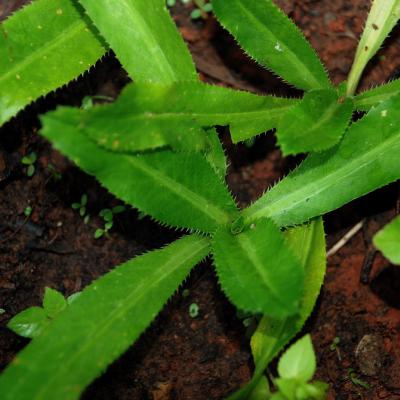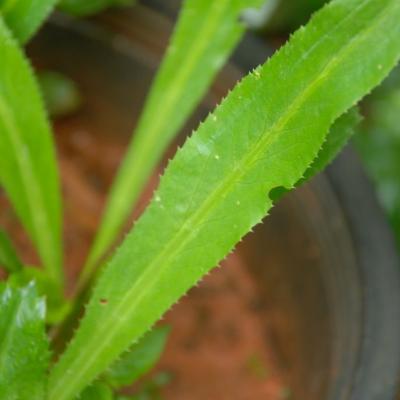Apiaceae-Eryngium-foetidum
Classification
- Botanical Family : Apiaceae
- Genus : Eryngium
- Epithet : foetidum
- German Family Name: Doldengewächse
- English Name: Saw leaf herb, Mexican coriander, Saw tooth coriander,
- Thai Name: ผักชีฝรั่ง
- Thai Phonetic: pak chi farang
- Author: L.
- Height: 0.30
Water Requirements
Plant Type
Light Requirements
Cultivation
Eryngium foetidum is a annual small plant (approx. 30 cm high), which is grown due to its use as a medicinal herb and spice. Can be bought in every fresh-vegetable market.
The aroma of the leaves are strong, very similar to fresh coriander leaves; taste similar, but even stronger.
It has white flowers, while the fruit is round. It flowers profusely and the flowers are clustered in spikes. Needs a partial shade or shady spot and always moist soil.
Grows also in a pot.
Propagation: sowing
Eryngium foetidum ist eine einjährige kleinwüchsige Pflanze (ca. 30 cm hoch), die wegen seiner Verwendung als Heilkraut und Gewürz angebaut wird. Kann auf jedem Gemüse-Markt frisch gekauft werden.
Der Geruch der Blätter ist sehr intensiv nach frischen Korianderblättern, der Geschmack ist ähnlich, aber stärker.
Es hat weiße Blüten, die Früchte sind rund. Die Blüten sind in Dolden angeordnet.
Braucht einen halbschattigen oder schattigen Platz und stets feuchte Erde.
Kann ebenso als Topfpflanze gehalten werden.
Vermehrung: Aussaat
Origin
Miscelaneous
Use
In the kitchen, Eryngium foetidum can be used such as coriander. With the fresh leaves, seasons salads and sauces and garnished dishes before serving. Eryngium foetidum should be used always raw and fresh. The dryed herb as well as long cooking loose the great taste.
Eryngium foetidum is rich in iron, carotene, riboflavin and calcium.
Ethnomedical uses
The ethnomedical information is provided for general information only, it is not intended as guidance for medicinal use.
Leaves and roots are used.
India - the root is used to soothe stomach pains. (1)
Further it is used as a tea for diarrhea, flu, fevers, vomiting, diabetes and constipation. (1)
Southamerica - a decoction from the leaves exerts an anti-inflammatory effect, when administered orally. (2)
(1) Culantro: A Much Utilized, Little Understood Herb Christopher Ramcharan 1999. p. 506–509. In: J. Janick (ed.), Perspectives on new crops and new uses. ASHS Press, Alexandria, VA. http://www.hort.purdue.edu/newcrop/proceedings1999/v4-506.html#medicinal
(2) M. T. Sáenz, M. A. Fernández, M. D. García. "Antiinflammatory and analgesic properties from leaves of Eryngium foetidum L. (Apiaceae)" Phytotherapy Research, Volume 11, Issue 5, p. 380–383. http://onlinelibrary.wiley.com/doi/10.1002/(SICI)1099-1573(199708)11:5%3C380::AID-PTR116%3E3.0.CO;2-%23/abstract
Verwendung:
In der Küche kann Eryngium foetidum wie Koriander verwendet werden. Mit den frischen Blättern würzt man Salate und Saucen und garniert Speisen vor dem Anrichten. Eryngium foetidum sollte immer roh und frisch verwendet werden, da sowohl beim Trocknen als auch beim längeren Kochen große Geschmackseinbußen auftreten.
Eryngium foetidum ist reich an Eisen, Carotin, Riboflavin und Calcium.
Volksmedizinische Verwendung
Die Berichte über volksmedizinische Verwendung ist nur zur allgemeinen Information und nicht als medizinischer Ratgeber zu betrachten.
Verwendet werden Blätter und Wurzel.
Indien - die Wurzel wird verwendet, um Bauchschmerzen zu beruhigen. (1)
Weiter wird es als Tee verwendet gegen, Durchfall, Grippe, Fieber, Erbrechen, Diabetes und Verstopfung. (1)
Südamerika - ein Sud aus den Blättern übt eine entzündungshemmende Wirkung aus, wenn es oral verabreicht wird. (2)
(1) Culantro: A Much Utilized, Little Understood Herb Christopher Ramcharan 1999. p. 506–509. In: J. Janick (ed.), Perspectives on new crops and new uses. ASHS Press, Alexandria, VA. http://www.hort.purdue.edu/newcrop/proceedings1999/v4-506.html#medicinal
(2) M. T. Sáenz, M. A. Fernández, M. D. García. "Antiinflammatory and analgesic properties from leaves of Eryngium foetidum L. (Apiaceae)" Phytotherapy Research, Volume 11, Issue 5, p. 380–383. http://onlinelibrary.wiley.com/doi/10.1002/(SICI)1099-1573(199708)11:5%3C380::AID-PTR116%3E3.0.CO;2-%23/abstract


